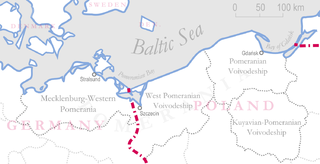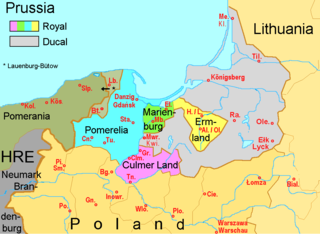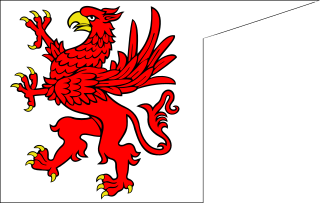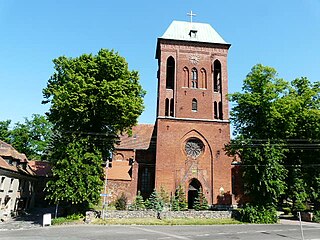Related Research Articles

Pomerania is a historical region on the southern shore of the Baltic Sea in Central Europe, split between Poland and Germany. The western part of Pomerania belongs to the German states of Mecklenburg-Western Pomerania and Brandenburg, while the eastern part belongs to the West Pomeranian and Pomeranian voivodeships of Poland. Its historical border in the west is the Mecklenburg-Western Pomeranian border valley, which now constitutes the border between the Mecklenburgian and Pomeranian part of Mecklenburg-Western Pomerania, while it is bounded by the Vistula River in the east. The easternmost sub-regions of Pomerania are alternatively known as Pomerelia and Kashubia, which are inhabited by ethnic Kashubians.

Pomerelia, also referred to as Eastern Pomerania, Vistula Pomerania, or Gdańsk Pomerania, the latter term not covering the Chełmno Land, is a historical sub-region of Pomerania, in northern Poland. Pomerelia lay on the southern shore of the Baltic Sea, west of the Vistula river and east of the Łeba river. Its largest and most important city is Gdańsk. Since 1999 the region has formed the core of the Pomeranian Voivodeship. Gdańsk Pomerania is traditionally divided into Kashubia, Kociewie, Tuchola Forest and Chełmno Land, with southern part located in the Kuyavian-Pomeranian Voivodeship and small parts in West Pomeranian Voivodeship. The region has been inhabited by ethnic Kashubians, Kociewians, Borowians and Chełminians, respectively.

The Duchy of Pomerania was a duchy in Pomerania on the southern coast of the Baltic Sea, ruled by dukes of the House of Pomerania (Griffins). The country had existed in the Middle Ages, in years 1121–1160, 1264–1295, 1478–1531 and 1625–1637.

The history of Pomerania starts shortly before 1000 AD with ongoing conquests by newly arrived Polans rulers. Before that the area was recorded nearly 2000 years ago as Germania, and in modern-day times Pomerania is split between Germany and Poland. The name Pomerania comes from the Slavic po more, which means Land at the Sea.

Farther Pomerania, Further Pomerania, or Eastern Pomerania, is the part of Pomerania which comprised the eastern part of the Duchy and later Province of Pomerania. It stretched roughly from the Oder River in the West to Pomerelia in the East. Since 1945, Farther Pomerania has been part of Poland; the bulk of former Farther Pomerania is within the West Pomeranian Voivodeship, while its easternmost parts are within the Pomeranian Voivodeship. The Polish term Pomorze Zachodnie, in modern Polish usage, is a synonym to the West Pomeranian Voivodship; in Polish historical usage it applied to all areas west of Pomerelia.

Wolin is a town in northwestern Poland, situated on the southern tip of the Wolin island off the Baltic coast of the historic region of Pomerania. The island lies at the edge of the strait of Dziwna in Kamień County, West Pomeranian Voivodeship.

The Bishopric of Cammin was both a former Roman Catholic diocese in the Duchy of Pomerania from 1140 to 1544, and a secular territory of the Holy Roman Empire (Prince-Bishopric) in the Kolberg (Kołobrzeg) area from 1248 to 1650.

The Lands of Schlawe and Stolp or Land of Słupsk-Sławno are a historical region in Pomerania, centered on the towns of Sławno (Schlawe) and Słupsk (Stolp) in Farther Pomerania, in present-day Poland.

Pomerania during the High Middle Ages covers the history of Pomerania in the 12th and 13th centuries.

Pomerania during the Late Middle Ages covers the history of Pomerania in the 14th and 15th centuries.

History of Pomerania (1945–present) covers the history of Pomerania during World War II aftermath, the Communist and since 1989 Democratic era.
Medieval Pomerania was converted from Slavic paganism to Christianity by Otto von Bamberg in 1124 and 1128, and in 1168 by Absalon.

Pomerania-Stolp was one of the partitions of the Duchy of Pomerania. Centered in Słupsk, it was created from another partition of the Duchy of Pomerania, Pomerania-Wolgast, to satisfy Bogislaw V, Duke of Pomerania in 1368, and existed until 1459, when it was inherited by Eric II of Pomerania-Wolgast. In 1474, it was merged to the partition of Bogislaw X, Duke of Pomerania, who four years later became the sole duke of Pomerania.
The Duchy of Pomerania was partitioned several times to satisfy the claims of the male members of the ruling House of Pomerania dynasty. The partitions were named after the ducal residences: Pomerania-Barth, -Demmin, -Rügenwalde, -Stettin, -Stolp, and -Wolgast. None of the partitions had a hereditary character, the members of the House of Pomerania inherited the duchy in common. The duchy thus continued to exist as a whole despite its division. The only exception was made during a war with the Margraviate of Brandenburg, when in 1338 Barnim III of Pomerania-Stettin was granted his partition as a fief directly from the Holy Roman Emperor, while Pomerania-Wolgast remained under formal Brandenburgian overlordship. However, already in 1348, German king and later emperor Charles IV again granted the Duchy of Pomerania as a whole and the Principality of Rügen as a fief to the dukes of both Pomerania-Stettin and Pomerania-Wolgast, nullifying Brandenburg's claims by granting Imperial immediacy.

Bogisław VIII, a member of the House of Griffins, was Duke of Pomerania ruling in Pomerania-Stolp from 1395 until his death. He also served as administrator of the Prince-Bishopric of Cammin from 1387 and as Cammin Prince-bishop from 1394 to 1398.
The Prissani or Pyritzans were a medieval tribe in Pomerania. They were first mentioned as "Prissani" with 70 civitas by the Bavarian Geographer, ca. 845. They are associated with the Pomeranians, and were based in the lower Oder region around the modern town of Pyrzyce (Pyritz). The mention in the Bavarian Geographer is the only written record referring to the tribe.
The Treaty of Soldin was signed on 21 January 1466 at Soldin by the Brandenburgian elector Frederick II and the Pomeranian dukes Eric II and Wartislaw X. It was mediated by the town of Stettin. The treaty temporarily settled a conflict about the succession of Otto III, Duke of Pomerania, who had died without issue: Emperor Frederick III, elector Frederick II as well as Eric II and Wartislaw X of Pomerania claimed to be the rightful heir of Otto's share of the Duchy of Pomerania.
Starting in the 12th century, the Margraviate, later Electorate, of Brandenburg was in conflict with the neighboring Duchy of Pomerania over frontier territories claimed by them both, and over the status of the Pomeranian duchy, which Brandenburg claimed as a fief, whereas Pomerania claimed Imperial immediacy. The conflict frequently turned into open war, and despite occasional success, none of the parties prevailed permanently until the House of Pomerania died out in 1637. Brandenburg would by then have naturally have prevailed, but this was hindered by the contemporary Swedish occupation of Pomerania, and the conflict continued between Sweden and Brandenburg-Prussia until 1815, when Prussia incorporated Swedish Pomerania into her Province of Pomerania.
Wartislaw VII was one of the Dukes of Pomerania. His full name was Henry Wartislaw.
Wartislaw VIII was a duke of Pomerania from the House of Griffins house. He ruled in Pomerania-Wolgast from 1394 together with his brother Barnim VI. After Barnim died in 1405, he ruled alone.
References
- ↑ Heitz, Gerhard; Rischer, Henning (1995). Geschichte in Daten. Mecklenburg-Vorpommern (in German). Münster-Berlin: Koehler&Amelang. p. 187. ISBN 3-7338-0195-4.
- ↑ Inachin, Kyra T. (2008). Die Geschichte Pommerns (in German). Rostock: Hinstorff. p. 36. ISBN 978-3-356-01044-2.
- ↑ Michael Müller-Wille, ed. (1995). Slawen und Deutsche im südlichen Ostseeraum vom 11. bis zum 16. Jahrhundert. Wachholtz. p. 153. ISBN 3-529-06452-1.
- 1 2 Werner Buchholz, Pommern, Siedler, 1999, p.157, ISBN 3-88680-272-8
- ↑ Czacharowski, Antoni (2001). Bürgertum und Rittertum im Spätmittelalter. Uniwersytetu Mikołaja Kopernika. p. 146. ISBN 83-231-1304-1.
- 1 2 Władysław Czapliński, Tadeusz Ładogórski, Atlas historyczny polski, Państwowe Przedsiębiorstwo Wydawnictw Kartograficznych, 1970, p.12
- 1 2 3 4 5 6 7 Branig, Hans; Werner Buchholz (1997). Werner Buchholz (ed.). Geschichte Pommerns, Volume I, Vom Werden des neuzeitlichen Staates bis zum Verlust der staatlichen Selbständigkeit, 1300-1648. Böhlau. pp. 29–30. ISBN 3-412-07189-7.
- ↑ Juliusz Bardach, Historia państwa i prawa Polski, Volume 1, Państwowe Wydawn. Naukowe, 1964, p.589
- ↑ Jasienica, Paweł (1978). Jagiellonian Poland. American Institute of Polish Culture. p. 100.
- ↑ Marceli Kosman, Na tropach bohaterów Krzyżaków, Książka i Wiedza, 1995, ISBN 83-05-12746-X, p.27
- ↑ Dzięgielewski, Jan (1995). Encyklopedia historii Polski: dzieje polityczne. II. Morex. p. 520. ISBN 83-904121-2-8.
- ↑ Czacharowski, Antoni (2001). Bürgertum und Rittertum im Spätmittelalter. Uniwersytetu Mikołaja Kopernika. pp. 146–148. ISBN 83-231-1304-1.
- ↑ Piskorski, Jan Maria (1999). Pommern im Wandel der Zeiten. Zamek Ksiazat Pomorskich. p. 103. ISBN 83-906184-8-6. OCLC 43087092.
- ↑ Branig, Hans; Werner Buchholz (1997). Werner Buchholz (ed.). Geschichte Pommerns, Volume I, Vom Werden des neuzeitlichen Staates bis zum Verlust der staatlichen Selbständigkeit, 1300-1648. Böhlau. p. 30. ISBN 3-412-07189-7.
- 1 2 Czacharowski, Antoni (2001). Bürgertum und Rittertum im Spätmittelalter. Uniwersytetu Mikołaja Kopernika. p. 148. ISBN 83-231-1304-1.
- ↑ Piskorski, Jan Maria (1999). Pommern im Wandel der Zeiten. Zamek Ksiazat Pomorskich. p. 117. ISBN 83-906184-8-6. OCLC 43087092.
- ↑ Zdrenka, Joachim (1995). "Die Pilgerfahrten der pommerschen Herzöge ins Heilige Land in den Jahren 1392/1393 und 1406/1407". Baltische Studien. Marburg: Elwert. 81 (127): 10–11.